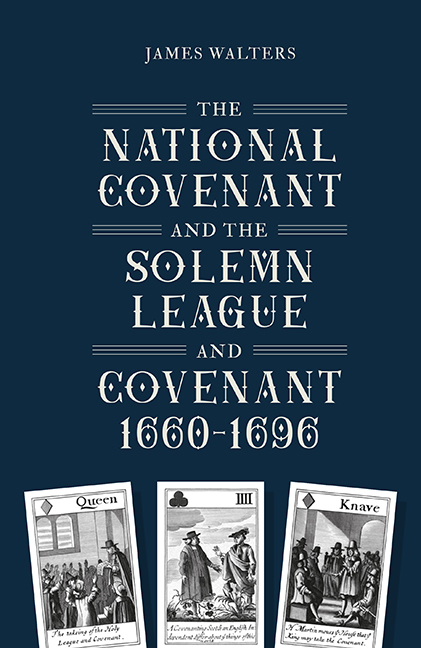Book contents
- Frontmatter
- Contentst
- List of Illustrations
- Acknowledgements
- Introduction
- 1 The 1638 National Covenant and the 1643 Solemn League and Covenant
- 2 1660: What Was to Be Restored?
- 3 The Act of Uniformity and the ‘Great Ejection’
- 4 Crisis and Toleration in the 1660s
- 5 Exclusion and Association in the Late Restoration Period
- 6 The Revolution of 1688 and the Association of 1696
- Conclusion
- Bibliography
- Index
- STUDIES IN EARLY MODERN CULTURAL, POLITICAL AND SOCIAL HISTORY
- Frontmatter
- Contentst
- List of Illustrations
- Acknowledgements
- Introduction
- 1 The 1638 National Covenant and the 1643 Solemn League and Covenant
- 2 1660: What Was to Be Restored?
- 3 The Act of Uniformity and the ‘Great Ejection’
- 4 Crisis and Toleration in the 1660s
- 5 Exclusion and Association in the Late Restoration Period
- 6 The Revolution of 1688 and the Association of 1696
- Conclusion
- Bibliography
- Index
- STUDIES IN EARLY MODERN CULTURAL, POLITICAL AND SOCIAL HISTORY
Summary
There are two sides to the story of the Covenants in the Restoration period. On the one hand, there is the story of how the documents themselves and their most dedicated supporters became increasingly marginalised and associated with sedition and armed rebellion. Many had high hopes in the early stages that there might be some place for the Solemn League and Covenant in the Restoration settlement. The ejection of presbyterian ministers from the Church of England on ‘Black’ St Bartholomew's Day 1662, and the proscription of the Solemn League and Covenant in the Act of Uniformity, dashed these hopes. In Scotland, the Covenants were associated with armed uprisings in 1666 and 1679, and Covenanters were subject to persecution in the ‘killing times’ of the 1680s. By 1689, only the most radical ‘Cameronians’ remained committed enough to renew the Covenants at Lesmahagow, while many of the more moderate erstwhile supporters of the Covenants felt the introduction of presbyterianism after the Revolution of 1688 was an acceptable compromise.
On the other hand, however, there is the story of how the Covenants continued to feature in political and religious discourse in both positive and negative terms, and as living documents through which the problems of the Restoration settlement of church and crown were examined. Moreover, the political theories which underpinned the Covenants, of limited contractual kingship and a lawful settlement of church government separate from the monarchy, and the practice of public covenanting, became an increasingly important part of the politics of the British kingdoms. In the events and discourse surrounding the Revolution of 1688, much of the theory and practice represented in the Covenants was reimagined in service to a much broader conception of Protestantism which more closely resembled a civil religion than the exclusionary jure divino religion embodied in the Covenants. The influence of the Covenants, particularly the Solemn League and Covenant, in the Restoration period, is therefore significantly more complex and enduring than many historians have appreciated.
For some, interest in the Covenants was intensely personal. Many had sworn the Solemn League and Covenant during the civil war period and wrestled with the implications of conflicting loyalty to the Covenant and the restored regime.
- Type
- Chapter
- Information
- Publisher: Boydell & BrewerPrint publication year: 2022

